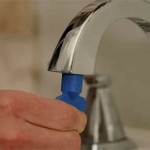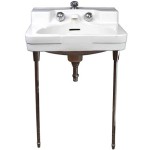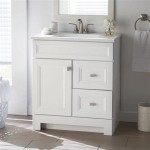Best Paint for Bathroom Sinks: A Comprehensive Guide
Selecting the optimal paint for a bathroom sink requires careful consideration of several factors. The bathroom environment is characterized by high humidity and frequent exposure to water, soap, and other cleaning agents. Consequently, the chosen paint must possess specific properties to withstand these challenging conditions and maintain its aesthetic appeal over time. This article will explore the key aspects of paint selection for bathroom sinks, focusing on durability, water resistance, mold resistance, and application techniques.
Understanding the Challenges of Painting Bathroom Sinks
Bathroom sinks present unique challenges for paint adhesion and longevity. Sinks are frequently exposed to moisture, which can lead to paint blistering, peeling, and cracking. Furthermore, the presence of mold and mildew is a common concern in bathrooms, necessitating the use of paints with mold-resistant properties. The type of material composing the sink itself also influences paint selection. Porcelain, ceramic, and even some metal sinks require specialized primers and paints to ensure adequate adhesion and prevent premature failure.
The sink's usage pattern further impacts the choice of paint. A heavily used sink will be subject to more wear and tear, requiring a more durable and scratch-resistant paint. Exposure to harsh cleaning chemicals also necessitates a paint that is resistant to degradation and discoloration. Careful assessment of these factors is crucial to selecting a paint that will provide long-lasting protection and maintain the sink's appearance.
Moreover, the existing condition of the sink plays a significant role in paint selection and preparation. If the sink has pre-existing damage such as chips, cracks, or stains, these imperfections must be addressed before painting. Proper surface preparation, including cleaning, sanding, and patching, is essential for achieving a smooth and durable finish. Neglecting these steps can compromise the adhesion of the paint and result in premature failure.
Key Paint Types for Bathroom Sinks
Several types of paint are suitable for use on bathroom sinks, each with its own advantages and disadvantages. The most common options include epoxy paints, acrylic urethane paints, and specialized enamel paints. Each offers varying degrees of durability, water resistance, and ease of application.
Epoxy Paints: Epoxy paints are renowned for their exceptional durability and resistance to chemicals and abrasion. They form a hard, impermeable coating that is highly resistant to water damage and staining. Epoxy paints are often used in industrial settings due to their robust performance, making them a suitable choice for high-use bathroom sinks. However, epoxy paints can be more challenging to apply than other types of paint. They typically require a two-part mixing process and may emit strong fumes during application. Proper ventilation and the use of appropriate safety equipment are essential when working with epoxy paints.
Acrylic Urethane Paints: Acrylic urethane paints offer a good balance of durability, water resistance, and ease of application. They are less prone to chipping and cracking than many other types of paint and provide a smooth, glossy finish. Acrylic urethane paints are also relatively resistant to mold and mildew, making them a suitable choice for bathroom environments. These paints typically dry quickly and can be applied with a brush, roller, or sprayer. They are also available in a wide range of colors and finishes, allowing for greater design flexibility.
Specialized Enamel Paints: Enamel paints are known for their hard, glossy finish and excellent durability. They are resistant to water, scratches, and stains, making them a suitable choice for bathroom sinks. Specialized enamel paints designed specifically for bathroom fixtures often contain additives that enhance their mold and mildew resistance. These paints are typically easy to apply and can be found in a variety of colors and finishes. However, some enamel paints may contain volatile organic compounds (VOCs), so it is important to choose a low-VOC option whenever possible.
In addition to these main types, some specialized paints are formulated specifically for refinishing porcelain or ceramic surfaces. These paints often contain bonding agents that promote adhesion to these smooth, non-porous surfaces. They may also include additives that help to fill in minor imperfections and create a smooth, even finish. When working with specialized paints, it is important to follow the manufacturer's instructions carefully to ensure optimal results.
Essential Steps for Preparing and Painting a Bathroom Sink
Proper surface preparation is critical to achieving a durable and aesthetically pleasing paint job on a bathroom sink. The following steps outline the essential preparation and painting process:
Cleaning: Thoroughly clean the sink with a degreasing cleaner to remove any dirt, grease, soap scum, or other contaminants. Rinse the sink thoroughly with clean water and allow it to dry completely. This step is crucial for ensuring proper paint adhesion.
Sanding: Sand the surface of the sink with fine-grit sandpaper to create a slightly rough texture. This will help the primer and paint to adhere better. Be sure to sand evenly and avoid gouging the surface. Wipe away any sanding dust with a clean, damp cloth.
Repairing Damage: Fill any chips, cracks, or other imperfections with a suitable patching compound. Allow the compound to dry completely and then sand it smooth to match the surrounding surface. This step is essential for creating a smooth, even base for the paint.
Priming: Apply a high-quality primer specifically designed for use on bathroom fixtures. The primer will help to seal the surface, improve paint adhesion, and prevent stains from bleeding through. Allow the primer to dry completely according to the manufacturer's instructions. For porcelain or ceramic sinks, use an epoxy primer designed for slick, non-porous surfaces.
Painting: Apply the chosen paint in thin, even coats, allowing each coat to dry completely before applying the next. Use a brush, roller, or sprayer to apply the paint, depending on the type of paint and the desired finish. Avoid applying the paint too thickly, as this can lead to drips and runs. Two or three coats of paint are typically sufficient to achieve full coverage and a durable finish.
Sealing (Optional): Consider applying a clear sealant over the painted surface to provide extra protection against water damage and scratches. Choose a sealant that is specifically designed for use on bathroom fixtures. Apply the sealant in thin, even coats and allow it to dry completely before using the sink.
Curing: Allow the paint to cure completely according to the manufacturer's instructions before using the sink. This may take several days, depending on the type of paint and the ambient temperature and humidity. Avoid exposing the painted surface to water or harsh chemicals during the curing process.
Following these steps diligently will significantly improve the outcome of the painting project, resulting in a more durable and aesthetically pleasing finish.
Considering Additives and Specialized Coatings
Beyond the selection of the primary paint type, several additives and specialized coatings can further enhance the performance and longevity of the painted bathroom sink. These include mold inhibitors, UV protectants, and scratch-resistant coatings.
Mold Inhibitors: As bathrooms are prone to mold and mildew growth, incorporating a mold inhibitor into the paint can be a proactive measure. These additives are typically mixed directly into the paint before application and work by preventing the growth of mold and mildew on the painted surface. This is especially beneficial in areas with poor ventilation or high humidity.
UV Protectants: If the bathroom sink is exposed to direct sunlight, the addition of a UV protectant to the paint can help prevent fading and discoloration over time. UV protectants work by absorbing or reflecting ultraviolet radiation, thereby protecting the paint pigments from degradation.
Scratch-Resistant Coatings: For high-use sinks, a scratch-resistant coating can help maintain the appearance of the painted surface. These coatings form a hard, durable layer that is resistant to scratches, scuffs, and abrasions. They are particularly useful for sinks that are frequently exposed to sharp objects or abrasive cleaning agents. These coatings are often applied as a final layer after the paint has fully cured.
Careful consideration of these additives and coatings can significantly improve the overall performance and lifespan of the painted bathroom sink, ensuring that it remains both functional and aesthetically pleasing for years to come.

Transform Your Bathroom With Sink Paint The Honeycomb Home

Paint Bathroom Vanity Countertop Sink So Easy A Piece Of Rainbow

Transform Your Bathroom With Sink Paint The Honeycomb Home

Paint Bathroom Vanity Countertop Sink So Easy A Piece Of Rainbow

Paint Bathroom Vanity Countertop Sink So Easy A Piece Of Rainbow
:max_bytes(150000):strip_icc()/grey-08207753dd3b407caadbbb47253586a3.jpg?strip=all)
30 Bathroom Cabinet Color Ideas From Basic To Bold
:strip_icc()/cdn.cliqueinc.com__cache__posts__244439__bathroom-paint-colors-244439-1543863795193-main.700x0c-43c7f8fb3c6144d189fd86055fcb5bbb.jpg?strip=all)
30 Bathroom Paint Colors Interior Designers Swear By

Grey Paint Colors Us Interior Design Domestic

How To Paint Bathroom Cabinets Without Sanding 8 Vital Steps Grace In My Space

Transform Your Bathroom With Sink Paint The Honeycomb Home
Related Posts







